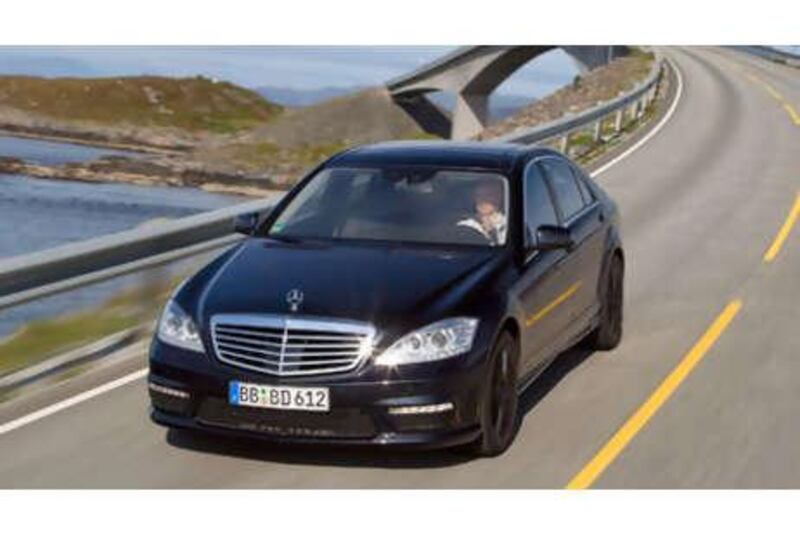Unlike the financial industry, even the most profligate of car makers are minding their social responsibility Ps and Qs these days. Complain, if you must, that the always-cynical auto industry is more concerned with the image of being green rather than actually changing its hue, but at least it's going through the motions, which is more than can be said for the folks over at Goldman Sachs. Even the most ardent hedonists - and certainly, Mercedes' tuning arm, AMG, is amongst the most shameless of bon vivantes - are looking to minimise their carbon footprint. That is, of course, as long as there's no sacrifice in performance or luxury. Caligula will always demand a smorgasbord, but his public relations expert just makes sure that the leftover scraps are parcelled out to the unworthy.
This demand to marry (relative) frugality with its traditionally over-the-top performance is the motivation behind AMG phasing out the naturally aspirated, 525hp, 6.2L V8 that it only so recently developed. In its stead, it has come up with a 5.5L turbocharged powerhouse that pumps out even more power, 544hp (571hp if you order the optional performance package). "Now, wait a minute," I hear you saying. "What a load of hooey; more horsepower doesn't sound very green. Mercedes is feeding you a line and now you're trying to feed it to me."
But Mercedes is not feeding us a line. Yes, it's true that, all things being equal, any petrol-combusting, internal combustion engine with more power will consume more fuel than one boasting less. But, as everyone can attest, things are never equal. For one thing, engines are seldom called on to produce their peak power for any significant periods of time. So, yes, while Mercedes' high-revving, naturally-aspirated 6.2L and the 2011 S63's new 5.4L twin-turbocharged V8s probably have similar fuel consumption when they are producing their 500-plus peak horsepower, how they act when they're poodling around at 100kph is dramatically different.
You see, once those turbochargers stop force-feeding fuel and air, the S63's new V8 reverts back to being a normal 5.5L engine that, being 747cc smaller, is significantly more frugal than the outgoing 6.2L. Throw in other advancements like direct injection and more efficient ancillaries - fuel pump, alternator, etc - and the new S63 boasts 25 per cent improved fuel economy - 10.5L/100km versus 14.4L/100km in the European driving cycle - over the outgoing 6.2L version. Mercedes also notes that the turbocharged engine's much increased torque (795Nm for the regular version, 895Nm for the performance package), available as low as 2,000 rpm, means the engine can be shifted into a taller gear sooner, keeping engine revs, and fuel consumption, to a minimum.
But that sensation of overwhelming torque is also the reason that the S63 feels like a sprinter in a lineman's body. Thanks to that bounty of Newton metres, the rather heavy (no official figures have been released, but it probably won't weigh less than 2,200kg) still scoots to 100kph in 4.5 seconds (4.4 if you've ordered the aforementioned performance package) compared with the outgoing model's 4.6 seconds.
There's a whole bunch less drama involved. Where punching the old 6.2's throttle resulted in a flurry of revs as well as its mind-boggling acceleration, the new S63 always seems to be loafing even when it's accelerating hard enough to pin you back in the seat. Matt the throttle and there's none of the traditional turbo lag while the engine gathers up its skirt for the impending sprint. Indeed, from inside the cabin, there's very little sensation of the engine working hard (although, passersby can easily be forgiven for mistaking the new S63's exhaust note for a McLaren SLR, the major difference being that the sedan is a tad quieter). Yet, throttle response is so immediate that you'd swear that 5.5L's throttle plate is hard-wired into your cranium rather than through the gas pedal. Even at 1,500rpm, barely above idle, the S63 is pumping out almost 680Nm, more than the 6.2L has at its peak. Ditto for the Porsche 911 Turbo.
Playing a huge part in the enhanced powertrain is the new seven-speed Multi-Clutch Transmission (MCT) that's making the rounds of Mercedes' sportier bolides. Based on the automatic with the same number of speeds, the MCT replaces the automatic's traditional torque converter with a wet, multi-plate clutch (as used in most motorcycles). It shifts far more quickly than the automatic yet is all but as smooth and, when in its manual mode, fairly emulates the dual-clutch manuals popularised by Audi. It can blip the throttle for downshifts and, as a further concession towards economy and enviromentalism, is equipped with an engine stop-start function that shuts down the engine at stoplights.
That's about it for changes to the new S63. Having improved the performance slightly and the fuel economy dramatically, AMG engineers can congratulate themselves on a job well done. That said, it's not a sure thing that the new 5.5L biturbo will supplant the 6.2L in all of AMG's "63" offerings. The company claims that the turbo engine is ideal for powering big, thundering sedans like the S-Class, but the naturally-aspirated 6.2L's more precise throttle response is still well suited to smaller, sportier models like the C-Class. Perhaps, then that's the new definition of automobile manufacturing hedonism - two engines with exactly the same number of pistons, roughly the same power output and sporting exactly the same "63" model designation. The rest of the world tries to cut the number of engines it manufactures; AMG proliferates.
The new S63 will arrive here in September and will start at Dh648,305.






